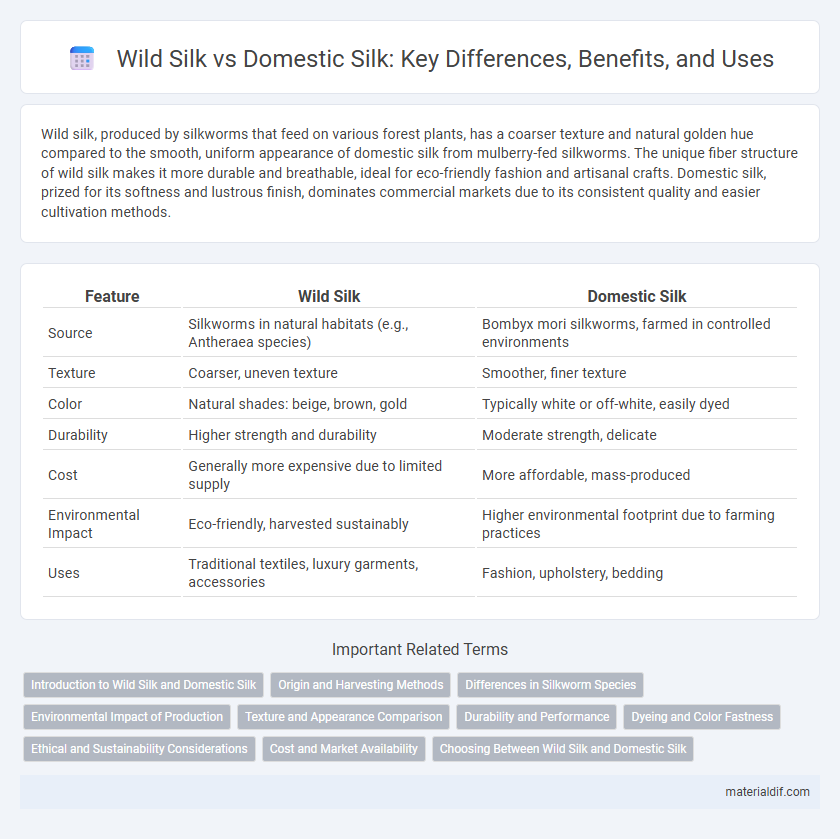Wild silk, produced by silkworms that feed on various forest plants, has a coarser texture and natural golden hue compared to the smooth, uniform appearance of domestic silk from mulberry-fed silkworms. The unique fiber structure of wild silk makes it more durable and breathable, ideal for eco-friendly fashion and artisanal crafts. Domestic silk, prized for its softness and lustrous finish, dominates commercial markets due to its consistent quality and easier cultivation methods.
Table of Comparison
| Feature | Wild Silk | Domestic Silk |
|---|---|---|
| Source | Silkworms in natural habitats (e.g., Antheraea species) | Bombyx mori silkworms, farmed in controlled environments |
| Texture | Coarser, uneven texture | Smoother, finer texture |
| Color | Natural shades: beige, brown, gold | Typically white or off-white, easily dyed |
| Durability | Higher strength and durability | Moderate strength, delicate |
| Cost | Generally more expensive due to limited supply | More affordable, mass-produced |
| Environmental Impact | Eco-friendly, harvested sustainably | Higher environmental footprint due to farming practices |
| Uses | Traditional textiles, luxury garments, accessories | Fashion, upholstery, bedding |
Introduction to Wild Silk and Domestic Silk
Wild silk, derived from silkworms living in natural habitats such as forests, exhibits coarser texture and greater durability compared to domestic silk, which originates from Bombyx mori silkworms raised in controlled environments. Domestic silk, known for its smoothness, uniformity, and lustrous finish, is the most commonly produced silk worldwide, primarily in countries like China and India. The distinction between wild and domestic silk impacts fabric texture, elasticity, color variation, and suitability for different textile applications.
Origin and Harvesting Methods
Wild silk originates from silkworms that thrive in natural forests, such as Antheraea mylitta found in India, harvesting involves collecting cocoons directly from trees without cultivation. Domestic silk is produced by Bombyx mori worms raised in controlled farms where cocoons are carefully cultivated and harvested to ensure uniform quality. The natural environment of wild silk causes variations in texture and color, while domestic silk offers a consistent and smoother fabric due to regulated rearing conditions.
Differences in Silkworm Species
Wild silk is produced by silkworm species such as Antheraea mylitta and Antheraea pernyi, which are not domesticated and feed on a variety of host plants like oak and castor leaves. Domestic silk comes from the Bombyx mori silkworm, a species specifically bred and fed mulberry leaves to produce uniform, fine, and lustrous silk fibers. The genetic and dietary differences between these species result in wild silk having thicker, coarser threads with natural color variations, while domestic silk offers smoother texture and consistent quality.
Environmental Impact of Production
Wild silk production typically has a lower environmental impact than domestic silk because it often relies on natural habitats and wild host plants, reducing the need for intensive farming and chemical inputs. Domestic silk farming requires large-scale mulberry cultivation, which can lead to significant water usage, pesticide application, and habitat alteration. The biodiversity preservation associated with wild silk harvesting contrasts with the monoculture practices in domestic silk production, making wild silk more sustainable in terms of ecosystem health.
Texture and Appearance Comparison
Wild silk features a coarser texture with a natural, uneven fiber thickness that gives it a rustic, matte appearance, often showcasing earthier tones such as tan or brown. Domestic silk has a smoother, finer texture resulting in a glossy and uniform appearance with bright, consistent colors like white, cream, or pastel shades. The natural irregularities in wild silk provide a distinctive tactile richness, while domestic silk offers a refined, lustrous finish favored in luxury textiles.
Durability and Performance
Wild silk, derived from non-domesticated silkworms, exhibits greater durability due to its naturally coarser fibers and higher tensile strength compared to domestic silk. Domestic silk, produced by cultivated Bombyx mori silkworms, offers smoother texture and consistent quality but tends to be less resilient under heavy wear. Performance-wise, wild silk's enhanced abrasion resistance and moisture-wicking properties make it suitable for robust textile applications, while domestic silk prioritizes softness and sheen for luxury garments.
Dyeing and Color Fastness
Wild silk exhibits lower dye absorption and reduced color fastness compared to domestic silk due to its coarser, uneven fiber structure. Domestic silk's fine, smooth filaments allow for more uniform dye penetration, resulting in vibrant, long-lasting hues. The natural sericin coating on wild silk also impedes dye adherence, necessitating additional processing to improve color durability.
Ethical and Sustainability Considerations
Wild silk production involves harvesting cocoons from silkworms living in natural habitats, promoting biodiversity but often resulting in inconsistent fiber quality and lower yields compared to domestic silk. Domestic silk farming, primarily using the Bombyx mori silkworm, allows for controlled rearing conditions that enhance fiber uniformity but raises ethical concerns due to the killing of pupae during silk extraction. Wild silk is generally considered more sustainable and ethically favorable because it supports wild ecosystems and avoids harm to larvae, whereas domestic silk prioritizes efficiency and commercial scalability at the potential cost of animal welfare and environmental impact.
Cost and Market Availability
Wild silk generally costs more than domestic silk due to limited production and the labor-intensive process of harvesting fibers from wild silkworms. Domestic silk benefits from large-scale cultivation and controlled farming environments, making it more affordable and widely available in global markets. Market availability for wild silk remains niche, catering to luxury and specialty segments, while domestic silk dominates mainstream textile industries worldwide.
Choosing Between Wild Silk and Domestic Silk
Choosing between wild silk and domestic silk depends on the desired texture, durability, and ethical considerations. Wild silk, known for its coarser texture and natural color variations, offers greater durability and unique aesthetic appeal compared to the smooth, lustrous finish of domestic silk derived from cultivated Bombyx mori silkworms. Factors such as environmental impact, silk source sustainability, and end-use application guide informed decisions in selecting the most suitable silk type for textile production or fashion design.
Wild silk vs domestic silk Infographic

 materialdif.com
materialdif.com